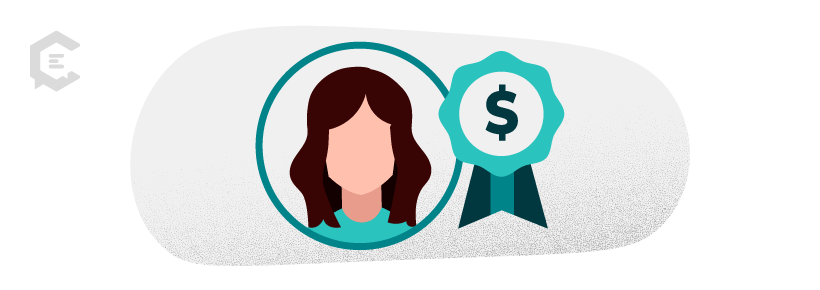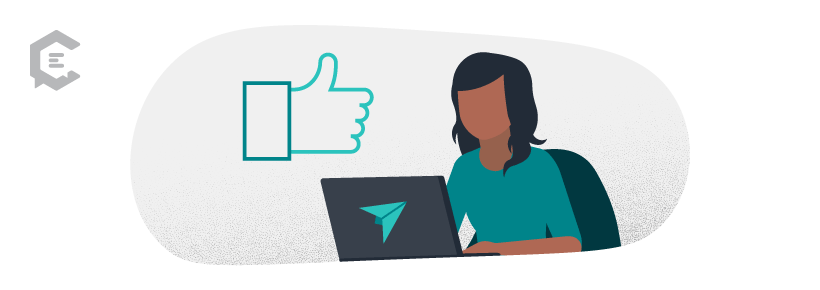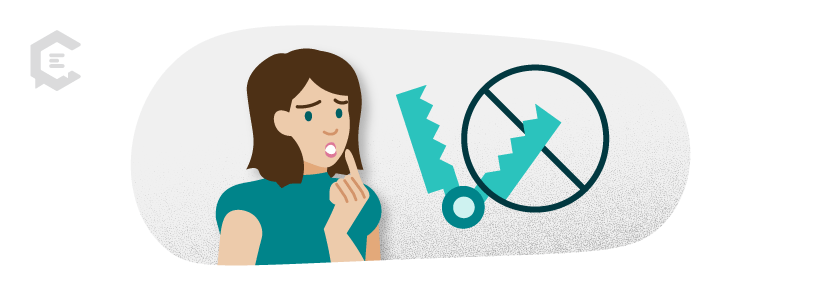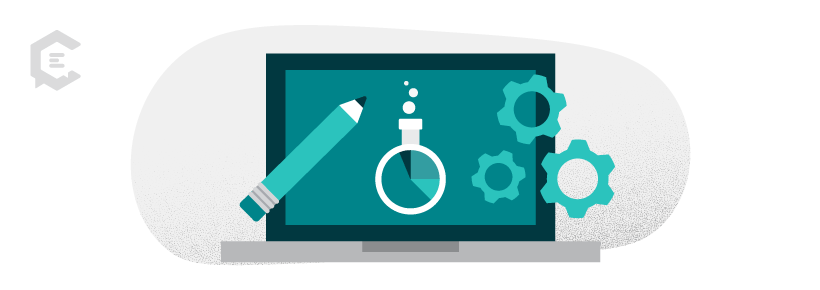Letting go of the comforts and protections of full-time employment and setting out on a freelance career is a terrifying jump. Even the most seasoned content marketing professionals can feel like they’re navigating a sea of unknowns. But there’s a reason it’s called taking a leap of faith.
There are also a lot of tips and tricks you can implement to give yourself the best chance of freelance success. In this article, we’ll cover the top benefits of freelancing, how to optimize your portfolio and LinkedIn profile, and the 4 best skills that can level up your career.

Becoming a Full-Time Freelance Content Marketer
Like many other freelancers who’ve come before you, before you make the transition, you have to:
- Build up your network
- Land some anchor clients
- Pad your savings account
Doing that will help fortify your ability to weather what will be plenty of financial storms (while also celebrating the economic wins). And, perhaps most importantly, accept the anxiety of an unsteady income stream that’s unpredictable. Before you know it, you’ll be a master at setting your own hours, deciding which assignments and clients to onboard, and creating a healthy work and life balance.
Part of being a solopreneur is learning to adjust on the fly
The ripple effect of COVID-19 became a crash course on pivoting for many marketers. And it’s created a whole new league of freelancers. And it’s potentially creating a whole new league of freelancers. Since the traditional job market slowed to a stand-till and a lot of marketers/content creators were laid off, it makes sense.
While at ClearVoice, we believe that freelancing can be one of the most rewarding career avenues, it’s essential to grasp the realities first. Although there are a lot of benefits, there’s also a lot of sacrifice. To reap success, it’s vital to effectively optimize your LinkedIn, your digital CV, and your website for consistent lead generation.
Last but not least, there is no real school of entrepreneurism, so investing in skill development will set your budding empire apart from the competition.
Sounds like a lot, right? It is. But luckily, we’re here to help.
Does the Market Need More Freelancers?
2024 is hard to predict. But a lot of freelance platform CEOs are optimistic, especially in freelance core verticals like marketing.
Right now, there are nearly 76 million freelancers in the U.S., a number that’s increasing by an average of about 3 million every year. Which coincides with what’s currently going on in the economy. The Tech Boom is over. Companies budgets are starting to shrink and they’re being asked to do more with less. One of the main ways they’re cutting costs is by eliminating overheard (like expensive full-time salaries with benefits) and outsourcing their work.
While this is discouraging for the vast majority of the workforce, it does provide a silver lining for freelancers of all ages and trades.
Here’s what we mean: Another way to define a freelancer is as a contractor. Typically hired for the duration of a project or with an agreement to produce various pieces of content, freelancers are not employed by companies but contracted to complete a specified amount of work. As brands start to think about moving forward, they will have limited budgets to operate with, and yet, they need to move fast.
That’s why freelancers are ideal, according to career expert Joe Mullings:
“As a contractor, there is an approximately 25 to 30 percent lower cost to the employer when you work in tax contribution, healthcare benefits, retirement benefits, paid time off, and holidays, to name a few. Organizations will likely go freelancer first and then potentially convert to a permanent hire as the new normal declares itself.”
When hiring a salaried employee, leaders have to consider the health of the employee, as well as work/life balance. State and federal regulations also require a certain expectation of output and offer protections to keep employees happy. Though it isn’t exactly a positive, freelancers are the navigators of their own ships — and they can choose to work as little or as much as they want.
As writer and marketing consultant Nick Wolny explains, companies will actively seek new ways to be agile and flexible with their labor. Thus, a skilled contractor can be a better and smarter investment since companies can ask for a 24-hour turnaround at a lower rate than onboarding a hire. It’s fast, easy, and, well, a lower risk.
“Freelancers come in on day one ready to move forward,” Wolny puts it.
4 Benefits of Full-Time Freelancing
Becoming your own boss brings a host of hurdles but also plenty of exciting perks.
1. You have full autonomy over your schedule
While some people thrive in the wee hours after sunset, others can barely make it out of bed before noon. Everyone’s peak periods of productivity vary, and with a traditional 9-to-5, it can be challenging to force yourself into a bubble that doesn’t energize you.
Full-time freelancing allows you the ability to set hours that will enable you to perform at your highest capacity. It also takes away some of the stressors of balancing work and life by giving you full autonomy of your schedule. You’ll have more time to take your dog for a walk, pick up the kids, make a doctor’s appointment, and so on.
2. Every day brings something new
Your parents may have enjoyed going to the same gig day in and day out for years. But younger generations are more attracted to jobs that continuously build their skills and spark their interest. If that rings a bell for you, full-time freelancing will feel like a breath of fresh air.
No week is ever precisely the same, providing more room for creativity and learning on the fly. You can work for a variety of companies in different sectors and different projects, keeping the work interesting and challenging while providing a lot of professional growth.
3. Your remote office can be anywhere in the world
Though your travel options are limited during a pandemic, generally speaking, freelancing provides more ZIP code flexibility.
As marketing consultant Brittany Graham shares, her favorite aspect of working for herself is the freedom to check emails, have client calls, and send invoices from any corner of the globe. As you consider making the transition to full-time freelancing, think about spending a month in Europe or the Caribbean, or really, anywhere you dream about. Though it’s important to strategize around the time zones of your clients, most of the time, you can make it work.
4. You can say “no”
Sure, if there is an aspect of your gig that you feel is unreasonable with an employer, you can always push back. However, that often leads to consequences or a potential setback. Wolny says as a freelancer, though, you can pick and choose who you want to work with, as well as the industries you prefer. Once you figure out your sweet spot, you can spend time attracting clients who fit your needs and would benefit from your super skills, and thus, design the work-life you want.
4 Pitfalls of Freelancing Full-Time
From the outside admiring in, being your own boss seems, well, amazing. And as solopreneurs will tell you, sometimes it is. Other times, it’s stressful and exhausting. Some months you can’t believe how well you’re doing, and others, you crave any lead at all.
Before you focus solely on the rose-colored benefits of freelancing, make sure you understand these potential pitfalls.
1. Income is never guaranteed
Regardless if you’ve been freelancing for 10 years or a few months, there is no monthly guarantee of income. Though some contracts do last for several months or even a year, contractors are at-will employees, and usually, can be canceled with only 30 days of notice.
While a full-time professional can expect a steady paycheck, a freelancer has zero guarantees. That means you need to be very good at saving and financial planning to offset the dry spells where you’re bringing in little to no income.
2. You have to figure out your own healthcare, retirement plans, and vacations
As part of a competitive employment package, companies will offer extensive benefits, including excellent healthcare coverage, 401K matching, and paid vacations (the list goes on). But as a freelancer, you’re responsible for all of that yourself.
Any time away from your business usually results in a loss of income. So, despite the freedom, the work hours can be grueling and often 24/7, depending on the project. That comes from needing to deliver for companies you want to hire you again.
You also need to research effective ways for retirement since companies won’t match your contributions to a 401k or Roth IRA. S0, before making the leap or deciding to pursue this type of career, do your best to prepare for the financial implications and shifts required.
3. Taxes are more complicated
Once you snag a handful of lucrative contracts, you’ll feel as if you’re floating on the financial cloud nine. But before you start spending all of that hard-earned dough, remember that you haven’t paid taxes yet. So technically, not all of that money is yours.
Mullings warns:
“You need to have some discipline to make the regular contributions for both federal and state taxes, where applicable, while you receive income. Many individuals who contract/freelance will get themselves in a difficult situation by spending and not setting aside the tax contributions they are responsible for, and come tax time, there is a big scramble.”
4. You have to always fuel your pipeline
For Graham, the hardest part about freelancing is finding new anchor clients. While this is always true, it’s particularly true during a pandemic. And, considering more freelancers will flock to this lifestyle, the competition will continue to become stiffer.
In addition to completing the work assigned to you, freelancers must always have an eye on the future, by pitching themselves and their services far and wide. In addition to networking groups and referrals, building your digital footprint through your CV and LinkedIn is an impactful way to create leads.
4 Ways to Optimize Your CV Portfolio for Full-Time Freelancing Work
When you’re job searching for traditional employment, you update your resume, brush up your cover letter, and dive into applications. When trying to build your freelancing empire, the process looks a little different. One of the most critical parts is developing your CV Portfolio so it captures the work you’ve completed for happy, returning clients.
Here are some top tips to strategize this vital part of your business:
1. Showcase your wins from a high-level
Whether it’s on the About or Home page of your website or portfolio, Graham encourages you to list out impressive high-level feats. Maybe, you’ve built a content strategy from the ground-up or you helped traffic grow by a certain percentage. Either way, these one-liners will encourage potential clients to keep reading.
As Graham says:
“By creating a portfolio or website, you can showcase your success with past or current clients, and demonstrate the relationships and type of work you can produce for others.”
2. Follow the same rubrics with client work
Wolny says it’s smarter to package past work samples in a way that will help future clients understand exactly the circumstances in which you took someone from point A to point B. That’s why those one-liners in the introduction should link out to or give a preview to a more in-depth explainer of your services:
“You control the narrative here. All too often, we assume prospects can relate to a previous client. They can’t because they’re too busy thinking about their own problems instead.”
To make it easy for them, he follows the same format that explains, in detail, the previous client’s problem, why they reached out, what other solutions they had tried, what he delivered, and the subsequent results. Plus, since you can’t always advertise your clients due to non-compete agreements, Wolny says this approach makes it easier to anonymize your projects while still demonstrating your success.
3. Celebrate the perks of freelance hiring
Are you currently based in one time zone, but the majority of your clients are in another? Does that allow you to work when they’re asleep and get ahead on projects? Or, do you tend to do your best work late at night, so your clients always wake up to an inbox full of content?
There are perks of flexible freelance schedules that many employers don’t think about, which is why Mullings suggests including them on your CV. You can go a step further and provide concrete examples of how these advantages worked in a past client’s favor, too.
4. Showcase your unique value
Every content marketer has a special talent that sets them above others in the industry. While some are super-skilled at SEO development, others excel at copywriting.
Wherever you fall, career expert and entrepreneur Jessica Zweig says to make it clear on your CV:
“Be able to distinguish and articulate your unique value, and what sets you apart from the rest. Share thought leadership content — blogs, videos, posts on social media — to let your work speak for itself.”
Business coach and podcaster Tiffany Carter also adds that when companies are hiring for freelance work, they are most interested in looking for concrete skill sets, versus hiring a generalist. So, be sure your CV has those skill sets they are looking for clearly listed.
4 Ways to Optimize Your LinkedIn as a Full-Time Freelancer
One killer source of leads is your social media footprint. Mainly, LinkedIn. This platform yields many opportunities to show up in search when companies are in the market for a content creator.
Try these practices to get started:
1. Mark yourself as available
Sort of like dating, if you don’t put yourself out there, it’s tough to find the right client match. Mullings recommends newbie freelancers to update their LinkedIn tag to ‘immediately available.’ This function lets potential leads know that you are ready to get started ASAP, which could be a selling point for a fast-turnaround project.
2. Write a clear summary
Considering you’re going after content marketing gigs, your LinkedIn summary should be 100 percent perfect. And by that, we mean no typos, no lead-on sentences, and definitely no confusing sentiments.
As Wolny puts it, your LinkedIn intro should clarify what the outcomes and benefits are when people hire you. “Zero in on those details first in the opening sentences of your introduction,” he suggests.
3. Update the media section
Have you ever given a second glance at the media section of your LinkedIn profile? Likely not, since Wolny says many people overlook it. As a content marketer, any commentary you’ve contributed can go a long way in demonstrating your impact and unique value. “Make sure to link to past features, including articles, videos, and other content assets. These can be effective for asserting industry expertise,” he explains.
Zweig also reminds freelancers that even if they work from home in their pajamas, their profile should still sway super professional. This includes a clear cover photo, headshot, headline, and description.
4. Share helpful, valuable content
When you’re advising a brand on its blog strategy, what is your typical recommendation for a posting schedule? Likely once a day, a week, or a month, depending on their goals. The worst thing anyone can do is to publish a ton of content and then go rogue. So why would you do the same on your LinkedIn?
Zweig encourages freelancers to actively share articles, blogs, videos, and other posts that demonstrate industry knowledge. With consistency, you clearly illustrate you have a pulse on the market. (Psst: you can even share this article!)
4 Skill Investments Every Full-Time Freelancer Should Make
When you decide to become your own boss, it comes with many more responsibilities than you expect. Not only are you on the hook for any content assignments or contract deliverables, but you need to become a salesperson. A bookkeeper. A business developer. A project manager. And many other hats you can’t predict.
As you start the process of going freelance full-time, consider these skill investments:
1. Take digital marketing courses
Before you can sell your services to a client in need, you should know the ins and outs of the skills required. These include, but are not limited to, SEO keyword research, basic copywriting, paid brand copy, product descriptions, blog development and management, inbound marketing, newsletter copy — and so on.
Check out our guide to determining the best digital marketing courses that can upgrade your resume to an expert level. And perhaps most importantly, your writing speed will become faster. This, more than anything else, Wolny says, strengthens your creativity muscle and can lead to a higher income. Faster, expert-level output equals more work, after all.
2. Learn to prospect online
You may be able to write captivating copy, but you’re not a bonafide salesperson. And definitely not for yourself. Wolny says the ability to reach, befriend new contacts, and turn conversations into clients takes practice. But when you master it, it can quickly fill up your calendar. By joining Facebook groups for content marketers, taking free e-courses on best sales practices, and other measures, you become more comfortable with this part of building a freelance business.
3. Develop a niche
If you don’t love something, you won’t stick with it. And even if, technically speaking, you can develop content marketing strategies for a pet brand, if you aren’t a big fan of animals, it’s likely not a fit for you. Or, you could be okay with website copy, but your real star power is in blog development. Let your strengths shine and zero in on a niche.
Says Carter:
“If you love writing, learn how to be an excellent copywriter for digital content. If you love spending time on social media, learn how to become a social media manager or a content creator.”
4. Find a mentor
Particularly in the beginning stages, reaching out to a content marketer and full-time freelancer you admire can be comforting and incredibly educational. As Carter explains, learning from a whiz who is already successfully doing what you desire to do can guide your path better than any e-course or article.
They can even recommend classes or certifications to consider and provide feedback on your website, LinkedIn, or CV. And if you build the relationship, it can be something to turn to when you need it.
“You will have a coach or a mentor that you can refer to for guidance when something comes up with a client,” she continues. “This will give you a great deal of confidence since you will know you have this extra support in your back pocket.”
Ready to Level Up Your Freelancing Career?
Everything in this article should give you a great start to your full-time freelancing plans, but there’s one more thing that can really help. That’s partnering with a content agency that can match your skills and expertise with the right companies. At ClearVoice, we’ve had a lot of success over the years giving freelancers their start or boosting their careers to the next level.
Look into joining our Talent Network to get yourself started and help the opportunities flood in.









